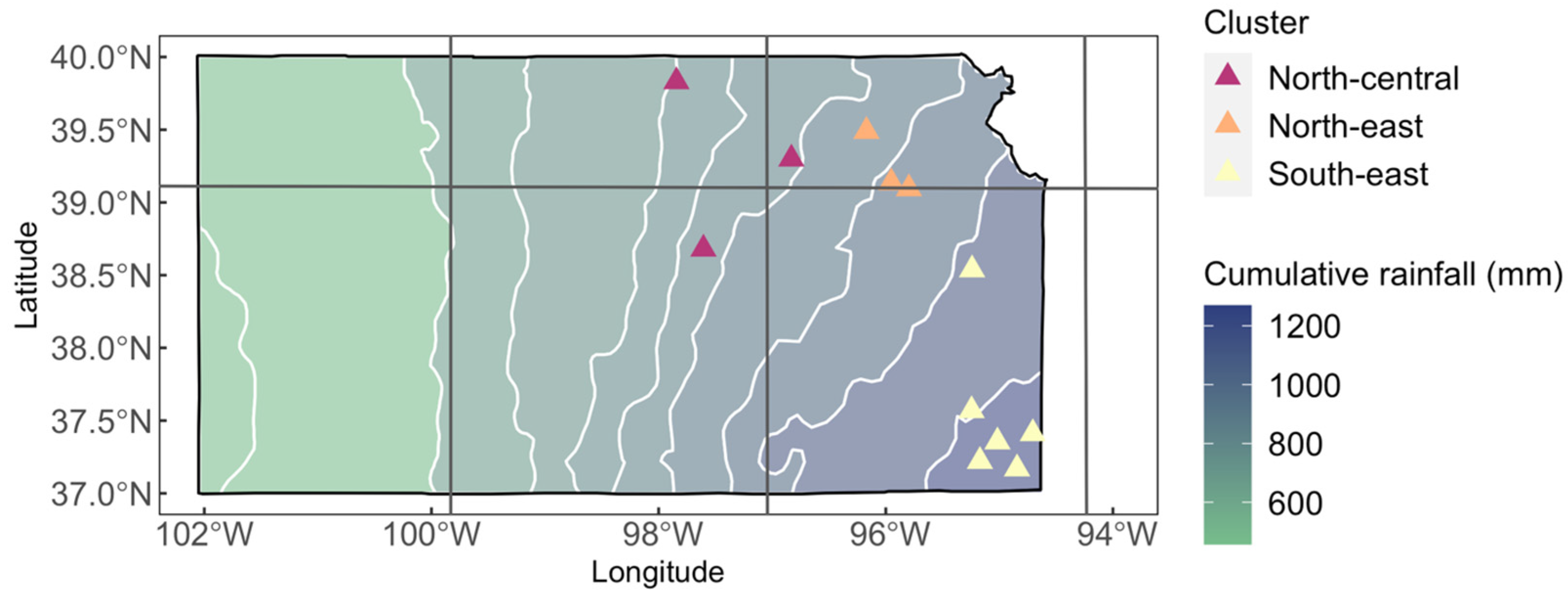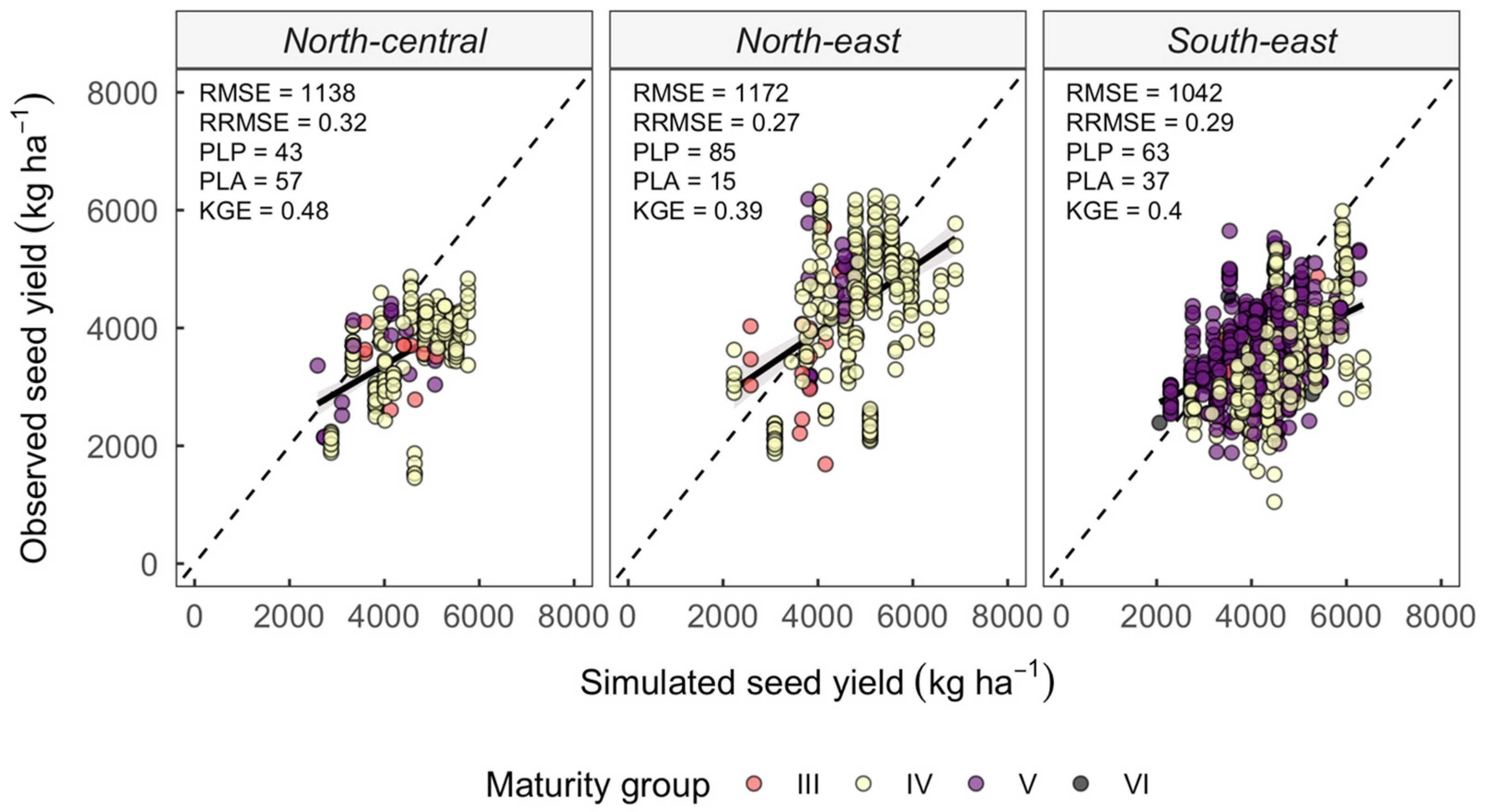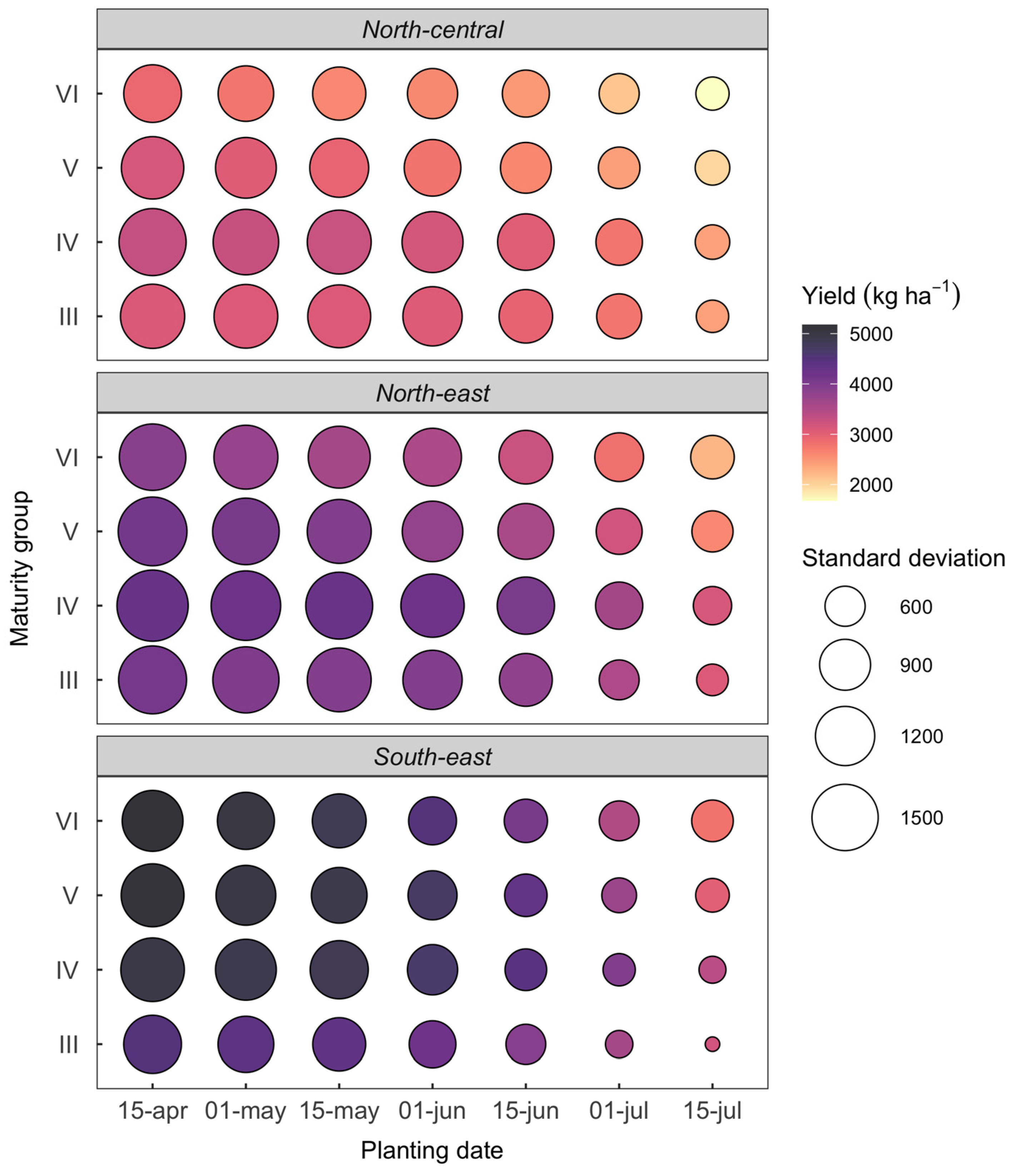Integrating Field Data and a Modeling Approach to Inform Optimum Planting Date × Maturity Group for Soybeans under Current and Future Weather Conditions in Kansas
Abstract
1. Introduction
2. Materials and Methods
2.1. Data Collection
2.2. Spatial Clustering
2.3. Model Validation
2.4. Developing Scenarios for Yield Stability for the Current and Future Weather
3. Results
3.1. Spatial Clustering
3.2. Model Validation
3.3. Developing Scenarios for Yield Stability for the Current Weather
3.4. Developing Scenarios for Yield Stability for the Future Weather Conditions
4. Discussion
5. Conclusions
Supplementary Materials
Author Contributions
Funding
Data Availability Statement
Acknowledgments
Conflicts of Interest
References
- FAOSTAT. Food and Agriculture Organization of the United Nations—Crops’ Data. Available online: http://www.fao.org/faostat/ (accessed on 20 April 2022).
- Reis, A.F.D.B.; Tamagno, S.; Rosso, L.H.M.; Ortez, O.A.; Naeve, S.; Ciampitti, I.A. Historical trend on seed amino acid concentration does not follow protein changes in soybeans. Sci. Rep. 2020, 10, 17707. [Google Scholar] [CrossRef] [PubMed]
- Carciochi, W.D.; Sadras, V.O.; Pagani, A.; Ciampitti, I.A. Co-limitation and stoichiometry capture the interacting effects of nitrogen and sulfur on maize yield and nutrient use efficiency. Eur. J. Agron. 2020, 113, 125973. [Google Scholar] [CrossRef]
- Correndo, A.A.; Adee, E.; Rosso, L.H.M.; Tremblay, N.; Prasad, P.V.V.; Du, J.; Ciampitti, I.A. Footprints of corn nitrogen management on the following soybean crop. Agron. J. 2022, 114, 1475–1488. [Google Scholar] [CrossRef]
- Egli, D.B.; Cornelius, P.L. A Regional Analysis of the Response of Soybean Yield to Planting Date. Agron. J. 2009, 101, 330–335. [Google Scholar] [CrossRef]
- Ciampitti, I.; Ciampitti, I.; Correndo, A.; van Versendaal, E. Soybean Planting Date and Maturity Group Selection. 2022. Available online: https://webapp.agron.ksu.edu/agr_social/m_eu_article.throck?article_id=3093&eu_id=490 (accessed on 10 May 2022).
- Egli, D.B.; Bruening, W.P. Potential of Early-Maturing Soybean Cultivars in Late Plantings. Agron. J. 2000, 92, 532–537. [Google Scholar] [CrossRef]
- Salmeron, M.; Gbur, E.E.; Bourland, F.M.; Buehring, N.W.; Earnest, L.; Fritschi, F.B.; Golden, B.R.; Hathcoat, D.; Lofton, J.; Miller, T.D.; et al. Soybean Maturity Group Choices for Early and Late Plantings in the Midsouth. Agron. J. 2014, 106, 1893–1901. [Google Scholar] [CrossRef]
- Stefanini, M.B.; Larson, J.A.; Smith, S.A.; Mengistu, A.; Bellaloui, N. Profitability and Risk Analysis of Soybean Planting Date by Maturity Group. Agron. J. 2015, 107, 2253–2262. [Google Scholar]
- Holzworth, D.P.; Huth, N.I.; Devoil, P.G.; Zurcher, E.J.; Herrmann, N.I.; McLean, G.; Chenu, K.; van Oosterom, E.J.; Snow, V.; Murphy, C.; et al. APSIM—Evolution towards a new generation of agricultural systems simulation. Environ. Model. Softw. 2014, 62, 327–350. [Google Scholar] [CrossRef]
- Kothari, K.; Battisti, R.; Boote, K.J.; Archontoulis, S.V.; Confalone, A.; Constantin, J.; Cuadra, S.V.; Debaeke, P.; Faye, B.; Grant, B.; et al. Are Soybean Models Ready for Climate Change Food Impact Assessments? Eur. J. Agron. 2022, 135, 126482. [Google Scholar] [CrossRef]
- Jin, Z.; Zhuang, Q.; Wang, J.; Archontoulis, S.V.; Zobel, Z.; Kotamarthi, V.R. The combined and separate impacts of climate extremes on the current and future US rainfed maize and soybean production under elevated CO2. Glob. Chang. Biol. 2017, 23, 2687–2704. [Google Scholar] [CrossRef] [PubMed]
- Schauberger, B.; Archontoulis, S.; Arneth, A.; Balkovic, J.; Ciais, P.; Deryng, D.; Elliott, J.; Folberth, C.; Khabarov, N.; Müller, C.; et al. Consistent negative response of US crops to high temperatures in observations and crop models. Nat. Commun. 2017, 8, 13931. [Google Scholar] [CrossRef] [PubMed]
- Zabel, F.; Müller, C.; Elliott, J.; Minoli, S.; Jägermeyr, J.; Schneider, J.M.; Franke, J.A.; Moyer, E.; Dury, M.; Francois, L.; et al. Large potential for crop production adaptation depends on available future varieties. Glob. Chang. Biol. 2021, 27, 3870–3882. [Google Scholar] [CrossRef] [PubMed]
- Brunsell, N.A.; Jones, A.R.; Jackson, T.L.; Feddema, J.J. Seasonal trends in air temperature and precipitation in IPCC AR4 GCM output for Kansas, USA: Evaluation and implications. Int. J. Clim. 2009, 30, 1178–1193. [Google Scholar] [CrossRef]
- Miguez, F. apsimx: Inspect, Read, Edit and Run ‘APSIM’ “Next Generation” and ‘APSIM’ Classic. R package version 2.3.1. 2022. Available online: https://CRAN.R-project.org/package=apsimx (accessed on 5 February 2022).
- Bezdek, J.C.; Ehrlich, R.; Full, W. FCM: The Fuzzy c-Means Clustering Algorithm. Compu. Geo. 1984, 10, 191–203. [Google Scholar] [CrossRef]
- Gelb, J.; Apparicio, P. Apport de la classification floue c-means spatiale en géographie: Essai de taxinomie socio-résidentielle et environnementale à Lyon. Cybergeo 2021, 1–26. [Google Scholar] [CrossRef]
- R Core Team. R: A Language and Environment for Statistical Computing, Version 4.0.3; R Foundation for Statistical Computing: Vienna, Austria, 2020; Available online: https://www.R-project.org/ (accessed on 5 February 2022).
- Gijsman, A.J.; Hoogenboom, G.; Parton, W.J.; Kerridge, P.C. Modifying DSSAT Crop Models for Low-Input Agricultural Systems Using a Soil Organic Matter–Residue Module from CENTURY. Agron. J. 2002, 94, 462–474. [Google Scholar] [CrossRef]
- Saxton, K.E.; Rawls, W.J. Soil Water Characteristic Estimates by Texture and Organic Matter for Hydrologic Solutions. Soil Sci. Soc. Am. J. 2006, 70, 1569–1578. [Google Scholar] [CrossRef]
- Fehr, W.R.; Cavinness, C.E. Stages of Soybean Development; Iowa State University: Ames, IA, USA, 1977; Available online: https://core.ac.uk/download/pdf/83024475.pdf (accessed on 20 April 2022).
- Kantolic, A.G.; Slafer, G. Photoperiod sensitivity after flowering and seed number determination in indeterminate soybean cultivars. Field Crop. Res. 2001, 72, 109–118. [Google Scholar] [CrossRef]
- Holzworth, D.; Huth, N.; Fainges, J.; Brown, H.; Zurcher, E.; Cichota, R.; Verrall, S.; Herrmann, N.; Zheng, B.; Snow, V. APSIM Next Generation: Overcoming challenges in modernising a farming systems model. Environ. Model. Softw. 2018, 103, 43–51. [Google Scholar] [CrossRef]
- Archontoulis, S.V.; Miguez, F.E.; Moore, K.J. A methology and an optimization tool to calibrate phenology of short-day species included in the APSIM PLANT model: Application to soybean. Environ. Model. Softw. 2014, 62, 465–477. Available online: https://www.sciencedirect.com/science/article/pii/S1364815214001133 (accessed on 15 February 2022). [CrossRef]
- Brown, H.E.; Huth, N.I.; Holzworth, D.P.; Teixeira, E.I.; Zyskowski, R.F.; Hargreaves, J.N.G.; Moot, D.J. Plant Modelling Framework: Software for Building and Running Crop Models on the APSIM Platform. Environ. Model. Softw. 2014, 62, 385–398. [Google Scholar] [CrossRef]
- Correndo, A.; Moro Rosso, L.; Schwalbert, R.; Hernandez, C.; Bastos, L.; Holzworth, D.; Ciampitti, I. Metrica: Prediction Performance Metrics. R Package Version 1.2.3. 2022. Available online: https://CRAN.R-project.org/package=metrica (accessed on 15 April 2022).
- Bates, D.; Mächler, M.; Bolker, B.; Walker, S. Fitting Linear Mixed-Effects Models Using lme4. J. Stat. Softw. 2015, 67, 48. [Google Scholar] [CrossRef]
- Lenth, R.V. emmeans: Estimated Marginal Means, aka Least-Squares Means. R Package Version 1.7.0. 2021. Available online: https://CRAN.R-project.org/package=emmeans (accessed on 15 April 2022).
- USDA-NASS. United States Department of Agriculture-National Agricultural Statistics Service. Available online: https://www.nass.usda.gov (accessed on 15 April 2022).
- Bastidas, A.M.; Setiyono, T.D.; Dobermann, A.; Cassman, K.G.; Elmore, R.W.; Graef, G.L.; Specht, J.E. Soybean Sowing Date: The Vegetative, Reproductive, and Agronomic Impacts. Crop. Sci. 2008, 48, 727–740. [Google Scholar] [CrossRef]
- De Bruin, J.L.; Pedersen, P. Soybean Seed Yield Response to Planting Date and Seeding Rate in the Upper Midwest. Agron. J. 2008, 100, 696–703. [Google Scholar] [CrossRef]
- Chen, G.; Wiatrak, P. Soybean Development and Yield Are Influenced by Planting Date and Environmental Conditions in the Southeastern Coastal Plain, United States. Agron. J. 2010, 102, 1731–1737. [Google Scholar] [CrossRef]
- Egli, D.B.; Bruening, W. Planting date and soybean yield: Evaluation of environmental effects with a crop simulation model: SOYGRO. Agric. For. Meteorol. 1992, 62, 19–29. [Google Scholar] [CrossRef]
- Heatherly, L.G.; Spurlock, S.R. Yield and economics of traditional and early soybean production system (ESPS) seedings in the midsouthern United States. Field Crop. Res. 1999, 63, 35–45. [Google Scholar] [CrossRef]
- Kessler, A.; Archontoulis, S.; Licht, M. Soybean yield and crop stage response to planting date and cultivar maturity in Iowa, USA. Agron. J. 2020, 112, 382–394. [Google Scholar] [CrossRef]
- Egli, D.B.; TeKrony, D.M. Seedbed Conditions and Prediction of Field Emergence of Soybean Seed. J. Prod. Agric. 1996, 9, 365–370. [Google Scholar] [CrossRef]
- Rizzo, G.; Mazzilli, S.R.; Ernst, O.; Baethgen, W.E.; Berger, A.G. Season-specific management strategies for rainfed soybean in the South American Pampas based on a seasonal precipitation forecast. Agric. Syst. 2021, 196, 103331. [Google Scholar] [CrossRef]
- Battisti, R.; Sentelhas, P.C.; Parker, P.S.; Nendel, C.; Câmara, G.M.D.S.; Farias, J.R.B.; Basso, C.J. Assessment of Crop-Management Strategies to Improve Soybean Resilience to Climate Change in Southern Brazil. Crop Pasture Sci. 2018, 69, 154. [Google Scholar] [CrossRef]
- Zhou, W.; Guan, K.; Peng, B.; Wang, Z.; Fu, R.; Li, B.; Ainsworth, E.A.; DeLucia, E.; Zhao, L.; Chen, Z. A generic risk assessment framework to evaluate historical and future climate-induced risk for rainfed corn and soybean yield in the U.S. Midwest. Weather. Clim. Extrem. 2021, 33, 100369. [Google Scholar] [CrossRef]
- Schlenker, W.; Roberts, M.J. Nonlinear temperature effects indicate severe damages to U.S. crop yields under climate change. Proc. Natl. Acad. Sci. USA 2009, 106, 15594–15598. [Google Scholar] [CrossRef]
- Mourtzinis, S.; Specht, J.E.; Lindsey, L.E.; Wiebold, W.J.; Ross, J.; Nafziger, E.D.; Kandel, H.J.; Mueller, N.; DeVillez, P.L.; Arriaga, F.J.; et al. Climate-induced reduction in US-wide soybean yields underpinned by region- and in-season-specific responses. Nat. Plants 2015, 1, 14026. [Google Scholar] [CrossRef]
- Mourtzinis, S.; Specht, J.E.; Conley, S.P. Defining Optimal Soybean Sowing Dates across the US. Sci. Rep. 2019, 9, 2800. [Google Scholar] [CrossRef]
- Elli, E.F.; Ciampitti, I.A.; Castellano, M.J.; Purcell, L.C.; Naeve, S.; Grassini, P.; La Menza, N.C.; Rosso, L.M.; Reis, A.F.d.B.; Kovács, P.; et al. Climate Change and Management Impacts on Soybean N Fixation, Soil N Mineralization, N2O Emissions, and Seed Yield. Front. Plant Sci. 2022, 13, 1097. [Google Scholar] [CrossRef] [PubMed]
- Battisti, R.; Sentelhas, P.C. Drought tolerance of brazilian soybean cultivars simulated by a simple agrometeorological yield model. Exp. Agric. 2014, 51, 285–298. [Google Scholar] [CrossRef]
- Kumagai, E.; Sameshima, R. Genotypic differences in soybean yield responses to increasing temperature in a cool climate are related to maturity group. Agric. For. Meteorol. 2014, 198–199, 265–272. [Google Scholar] [CrossRef]
- Liu, Y.; Dai, L. Modelling the impacts of climate change and crop management measures on soybean phenology in China. J. Clean. Prod. 2020, 262, 121271. [Google Scholar] [CrossRef]
- Rurinda, J.; van Wijk, M.T.; Mapfumo, P.; Descheemaeker, K.; Supit, I.; Giller, K.E. Climate change and maize yield in southern Africa: What can farm management do? Glob. Chang. Biol. 2015, 21, 4588–4601. [Google Scholar] [CrossRef]
- Rio, A.; Sentelhas, P.C.; Farias, J.R.B.; Sibaldelli, R.N.R.; Ferreira, R.C. Alternative sowing dates as a mitigation measure to reduce climate change impacts on soybean yields in southern Brazil. Int. J. Clim. 2015, 36, 3664–3672. [Google Scholar] [CrossRef]
- Wu, Y.; Wang, E.; He, D.; Liu, X.; Archontoulis, S.V.; Huth, N.I.; Zhao, Z.; Gong, W.; Yang, W. Combine observational data and modelling to quantify cultivar differences of soybean. Eur. J. Agron. 2019, 111, 125940. [Google Scholar] [CrossRef]
- Wallach, D.; Palosuo, T.; Thorburn, P.; Gourdain, E.; Asseng, S.; Basso, B.; Buis, S.; Crout, N.; Dibari, C.; Dumont, B.; et al. How well do crop modeling groups predict wheat phenology, given calibration data from the target population? Eur. J. Agron. 2021, 124, 126195. [Google Scholar] [CrossRef]
- Hoffmann, H.; Zhao, G.; Asseng, S.; Bindi, M.; Biernath, C.; Constantin, J.; Coucheney, E.; Dechow, R.; Doro, L.; Eckersten, H.; et al. Impact of Spatial Soil and Climate Input Data Aggregation on Regional Yield Simulations. PLoS ONE 2016, 11, e0151782. [Google Scholar] [CrossRef] [PubMed]




| Metric | Value |
|---|---|
| RMSE | 1084 |
| RRMSE | 0.29 |
| PLP | 68 |
| PLA | 32 |
| KGE | 0.44 |
Disclaimer/Publisher’s Note: The statements, opinions and data contained in all publications are solely those of the individual author(s) and contributor(s) and not of MDPI and/or the editor(s). MDPI and/or the editor(s) disclaim responsibility for any injury to people or property resulting from any ideas, methods, instructions or products referred to in the content. |
© 2023 by the authors. Licensee MDPI, Basel, Switzerland. This article is an open access article distributed under the terms and conditions of the Creative Commons Attribution (CC BY) license (https://creativecommons.org/licenses/by/4.0/).
Share and Cite
van Versendaal, E.; Carcedo, A.J.P.; Adee, E.; Sassenrath, G.; Dooley, S.; Lingenfelser, J.; Ciampitti, I.A. Integrating Field Data and a Modeling Approach to Inform Optimum Planting Date × Maturity Group for Soybeans under Current and Future Weather Conditions in Kansas. Sustainability 2023, 15, 1081. https://doi.org/10.3390/su15021081
van Versendaal E, Carcedo AJP, Adee E, Sassenrath G, Dooley S, Lingenfelser J, Ciampitti IA. Integrating Field Data and a Modeling Approach to Inform Optimum Planting Date × Maturity Group for Soybeans under Current and Future Weather Conditions in Kansas. Sustainability. 2023; 15(2):1081. https://doi.org/10.3390/su15021081
Chicago/Turabian Stylevan Versendaal, Emmanuela, Ana J. P. Carcedo, Eric Adee, Gretchen Sassenrath, Scott Dooley, Jane Lingenfelser, and Ignacio A. Ciampitti. 2023. "Integrating Field Data and a Modeling Approach to Inform Optimum Planting Date × Maturity Group for Soybeans under Current and Future Weather Conditions in Kansas" Sustainability 15, no. 2: 1081. https://doi.org/10.3390/su15021081
APA Stylevan Versendaal, E., Carcedo, A. J. P., Adee, E., Sassenrath, G., Dooley, S., Lingenfelser, J., & Ciampitti, I. A. (2023). Integrating Field Data and a Modeling Approach to Inform Optimum Planting Date × Maturity Group for Soybeans under Current and Future Weather Conditions in Kansas. Sustainability, 15(2), 1081. https://doi.org/10.3390/su15021081








